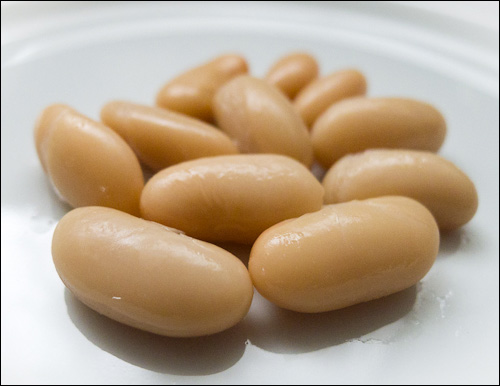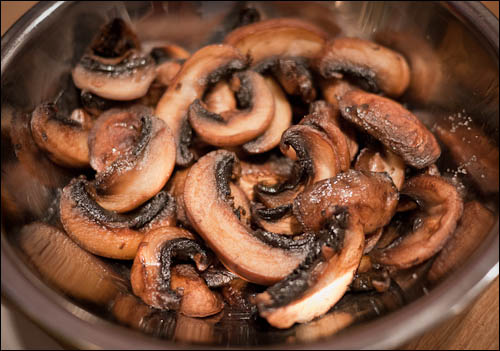I found Gwyneth Paltrow’s Thai-style chicken burgers recipe in Chatelaine magazine (May 2013) and it became something of a summer favourite for us this year.
The recipe comes from her It’s All Good cookbook, but it’s been reprinted all over the web, from Paltrow’s own Goop.com web site to various other magazine’s sites and 1001 blogs. It’s always reproduced exactly the same way (although there is at least one variation in the ingredients), which is a problem for me because I don’t like the way the method is described. This is normal for me as I virtually never like the way recipes are written. I alway re-write them when I’m transcribing them for my personal recipe book, and this one is no different.
The “improved” recipe below includes a few small ingredient changes (based on personal preference) and a greatly improved description of how to put it all together, including important information about how to deal with the very goopy nature of the meat before cooking. (I don’t know if I have the right to present the recipe here, especially if it is modified, but given that it’s already everywhere, and I’m giving attribution, and Gwyneth Paltrow seems to be a nice person, I’m going on the assumption it’s OK.)
I serve these burgers with lettuce and lime-pepper mayonnaise, which you can whip up in about 45 seconds using jarred mayo. The patties themselves pack so much flavour that it doesn’t seem right to pile on a bunch of extra things. These are best served as simply as possible.
A Note on the Goopy Texture
I confess I use supermarket ground chicken because I don’t have a meat grinder. Perhaps if you do grind your own this note won’t apply. (Hardly anyone on the web has mentioned this issue, and those who do usually add breadcrumbs as a binding agent.) But in my experience it has the texture and stickiness of fairly wet cookie dough after you’ve mixed in the aromatics and spices. This makes it hard to shape into patties, and even if you do, the patty loses its shape when you try to move it from a plate into the pan. There is also a high risk the burger will collapse and fall between the grates if you try to grill the burgers without firming them up in a pan first. The tips below will help you work around this problem:
- Don’t bother trying to shape the meat into a burger patty before cooking; Instead, just divide it into blobs and use the “smash burger†technique when you drop it into the pan (drop in the blob of meat then quickly smooth it into a patty shape using the back of a greased spoon).
- I do not recommend direct grilling (people say they do it, and I have done it, but it’s not fun and the burger can easily fall apart). I suggest frying them in a pan, or a combination of starting it in a pan (such as one of those grill-top cast iron pans) and finishing it on the grill. Both options are described in the recipe below.
- Cooking spray is your friend. Spray the plate on which you place the blobs of portioned meat, and use a spoon that you’ve sprayed for transferring to the pan and smashing (flattening) the patties.
Here are the modifications I made to the original recipe:
- From 3/4 cup of chopped cilantro to 1/2 cup (loosely packed) because it takes a TON of cilantro to even make 1/2 cup, and it seems like too much to me. (Note that some iterations of this recipe on the web specify 1/2 cup.)
- One teaspoon of sambal oelek instead of a teaspoon of minced red chile pepper. I always have samal oelek on hand, and I never have a single red chile pepper handy. This is an easy and sensible substitution.
- One teaspoon of fish sauce instead of two. Fish sauce is extremely salty and we should all be eating less salt.
- 1/4 teaspoon of coarse sea salt instead of 1/2 teaspoon. See note about salt, above.
- 1 teaspoon of mirin or agave syrup. This is not in the original recipe, but the magic of Thai food comes with the interplay of spicy, salty, sour, and sweet. This recipe has nothing sweet (except the shallots, and that’s a special kind of sweet). I find that a touch of sweetness helps here, especially since I use sambal oelek, which is a bit vinegary. You can add this or not. Just don’t add too much; a teaspoon, or two maximum.
Blork’s Improved Gwyneth Paltrow Thai Chicken Burgers
Ingredients
- 450 g (1 lb) ground chicken
- 2 cloves garlic, minced
- 1/2 cup finely chopped cilantro
- 2 shallots, minced
- 1 tsp sambal oelek
- 1 tsp fish sauce
- 1/4 tsp coarse sea salt (optional; the fish sauce 
is already very salty)
- 1/2 tsp freshly ground black pepper
- 1 tsp mirin or agave syrup (optional)
- 2 tbsp grapeseed (or equivalent neutral) oil
Method
- Mix the garlic, cilantro, shallots, sambal oelek, fish sauce, and salt & pepper in a large bowl. Stir it around until it’s mixed into a slurry.
- Add the ground chicken and mix. Try not to over-mix it; just stir and turn until it’s reasonably well mixed together.
- Divide into four (or six if you like them small) blobs on a greased plate.
- Cook in one of these two ways:
PAN:
– Heat a heavy pan until hot.
– Add the oil then drop the goopy blobs of meat onto the pan, quickly flattening them into a burger patty shape about 2 cm (3/4 inch) thick. Do this one at a time; drop, flatten, drop, flatten, etc.
– Cook for about 5-6 minutes per side (being careful not to over-brown) or until the internal temperature reaches 75C (165F).
GRILL:
– Heat the grill fairly high, and put a cast-iron grilling pan on it to heat up to hot.
– Put the oil in the grill pan, then drop the goopy blobs of meat onto the pan, quickly flattening them into a burger patty shape about 2 cm (3/4 inch) thick. Do this one at a time; drop, flatten, drop, flatten, etc.
– Cook for about 1 to 1-1/2 minutes per side, flipping when the underside is fairly browned.
– After both sides have browned, transfer to the grill and finish about 2-3 minutes per side or until the internal temperature reaches 75C (165F).
Serve on lightly toasted sesame buns with lime-pepper mayonnaise and lettuce.
Lime-pepper mayonnaise:
Mix about 1/3 cup of mayo with the juice of 1/2 a lime and a lot of coarsely ground black pepper.
Download an easy-to-print (one page) version of this recipe.






